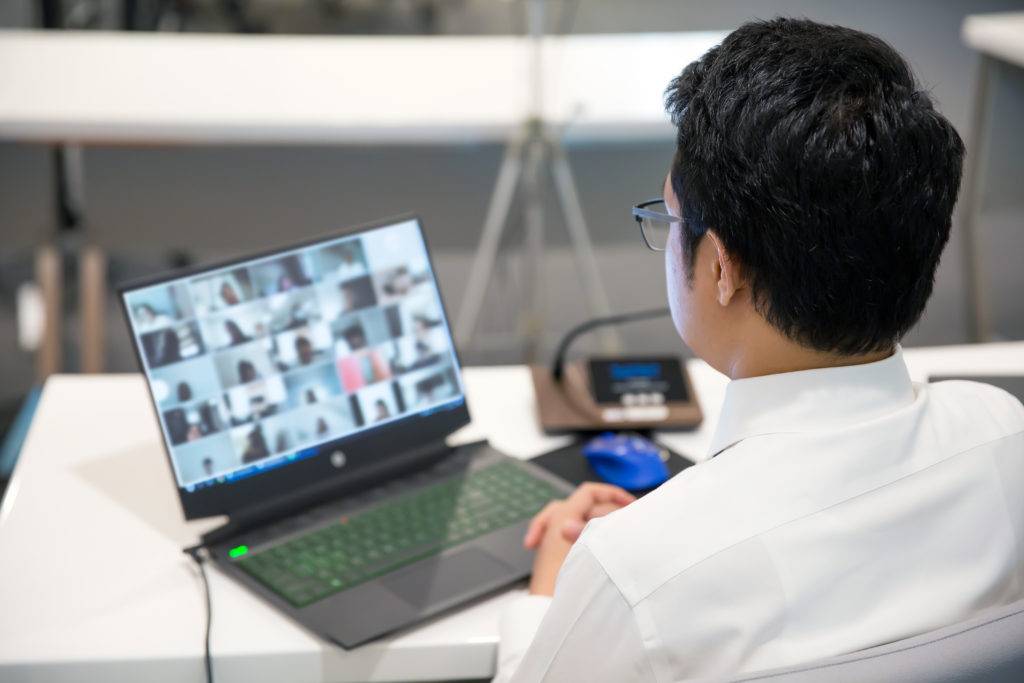
VoIP Video Conferencing for a Hybrid Workforce
VoIP video conferencing is now a business staple as it keeps us connected, productive, and efficient. In fact, global business spending on VoIP skyrocketed in 2020 as Covid-19 forced companies to shift to the cloud to maintain business continuity. But there’s more to VoIP than Zoom and Skype.
Suppose you want to get the video conferencing tool that’s right for your business and will deliver the best return on your investment. In that case, it’s helpful to have a good understanding of what other solutions are available and how they work.
What is VoIP Video Conferencing?
VoIP stands for voice over Internet protocol. It refers to making voice calls over the Internet instead of a traditional or analog phone line.
VoIP uses a digital telephony setup with messaging signals, channels, information digitization, and audio and video encoding. It works by transmitting digital information in IP packets over a network. There are both proprietary and open standard VoIP protocols used by various solutions.
VoIP video conferencing refers to solutions that can connect two or more people for live video communication. Even though VoIP can connect business apps like Zoom, you can also get it set up for yourself on a private VoIP service.
You could even go with a different communications channel because VoIP isn’t the only video conferencing solution available. Another option is a modified PBX system.
The PBX Alternative to VoIP Video Conferencing
PBX refers to private branch exchanges, which are independent, legacy business telephone systems. PBX networks originated back in the 1960s to facilitate intra-office calling. They were rendered slightly outdated when Internet-based SIP telephony came along.
However, PBX systems can now adapt to link into the cloud and offer more features like video conferencing. This is done by connecting your PBX to the Internet via a SIP trunk. Once that’s done, you can have a private video conferencing tool included in your business telecom solution.
Related: PBX and SIP: Learn the Basics
Why VoIP Video Conferencing is so Popular
VoIP is one of the most popular video conferencing protocols for various reasons. Apart from being one of the original online video chat solutions, it offers some hard-to-beat advantages for hybrid workforces, such as security, affordability, and easy accessibility. Let’s take a look at some of the benefits of VoIP.
Distributed Connections
You don’t need any landlines or physical phone setup to use VoIP. This is why it’s perfect for a distributed or hybrid- or remote workforce. As long as your employees have Internet access, they can get onto your video conferencing platform. They don’t need desktop computers or laptops. Most of these solutions offer mobile and tablet accessibility as well.
Workforce Collaboration
VoIP comes with more than video capabilities, as this technology has business collaboration purposes in mind. They can have interactive features like file sharing, whiteboards for interactive presentations, recording capabilities, screen sharing, messaging, note-taking, and document tools.
Remote Employee Bonding and Teamwork
Distributed employees can quickly feel isolated and disconnected. It can be challenging to develop a sense of being on the same team when you aren’t working in the physical vicinity of your colleagues. Consequently, companies have started using video conferencing for virtual water coolers, coffee break games, and trivia icebreakers.
Related: An Overview of VoIP Telephony (and How It Relates to SIP)
Remote Hiring, Onboarding and Training
Almost every HR manager wants to get face-to-face with potential new hires, but video interviews can replace in-person meetings when those aren’t feasible or convenient. Onboarding gets easier with video calls, especially when managers can screen share with employees to guide them through new software or business procedures. HR can also run video training classes for solo hires or groups of employees.
Workforce Engagement
If you want to keep engagement and interaction high, regular video discussions are the perfect tool.
Employees, colleagues, and managers are only a chat request away, making it easy for groups to collaborate on projects or activities.
Managers can run regular team meetings, check-ins, or offer periodic company updates through video conferencing.
Business Efficiency
VoIP video conferencing is a low-cost solution that ramps up productivity. It offers instant communication that can support a large number of people. It broadens your reach without any long-distance telecom charges. In some cases, it can slash the time spent in meetings.
Videoconferencing can be beneficial for almost any business. Still, VoIP is not always the right choice.
Where Do Alternatives Like PBX Win Out?
It is fairly easy to get a VoIP video conferencing solution. But some people opt for other communication channels like PBX systems. That’s because using your own PBX for video collaboration can bring a few advantages.
Here are some of them:
· No downloads, apps, or new solution accounts needed
· Lower cost since it runs on your Internet connection and doesn’t charge by seat
· Integrated into your business network, SMS, and telecom system
· Fully encrypted within your secure network
· Easy, cost-effective scaling that goes with your company’s growth
· No time limits since there’s no third-party solution that needs to restrict your usage
· No high running costs when you aren’t using it
What Would Work Better for Your Business, VoIP or a PBX Video Solution?
You don’t have to make your choice based on perceived legacy system restrictions. Even if your business uses PBX telephony, you can use SIP trunking to access either a leading VoIP video conferencing platform or develop your own cloud collaboration tool.
SIP trunking facilitates Internet-based business communications. It’s the way to go when you want to use the latest solutions or create your own unified network. And this is easier than you might think when you have a leading SIP provider on your side.
At SIP.US, we’ve been implementing cutting-edge business telephony since 2007. Talk to us about how we can enable the video conferencing solution that’s right for you. Or get started today with a free SIP trial account.


